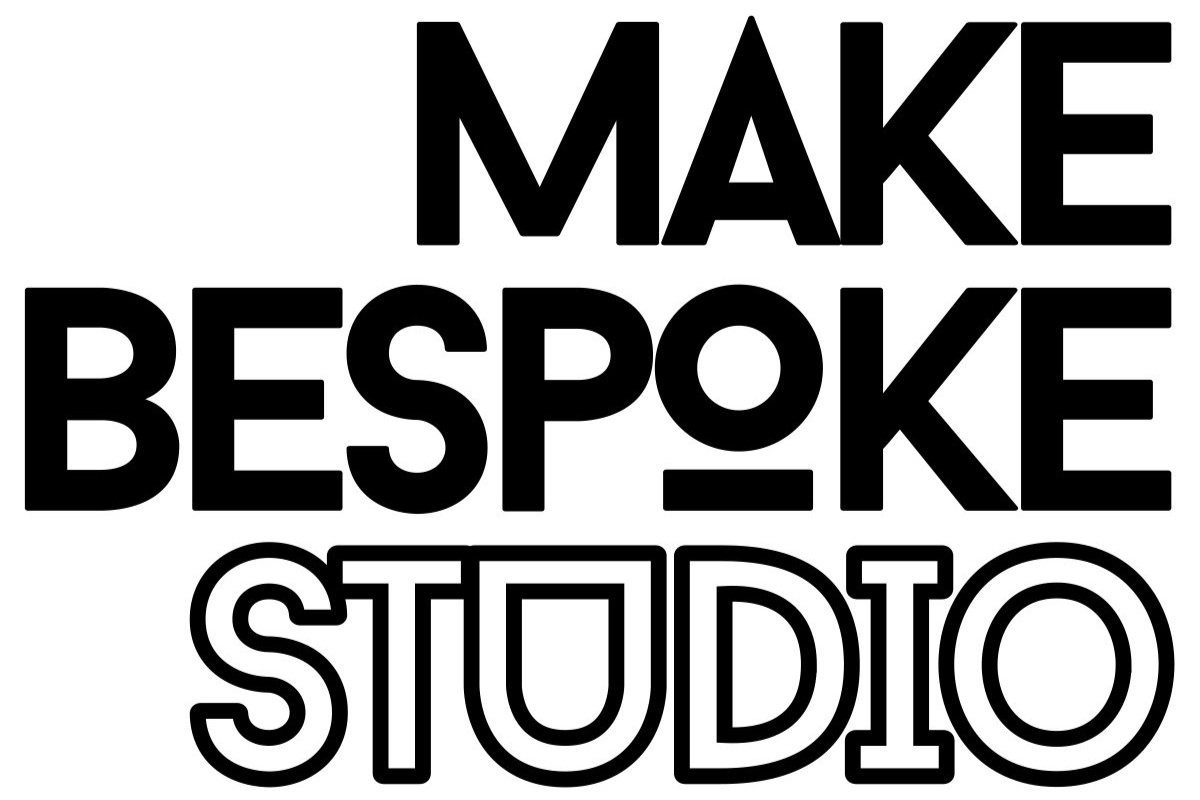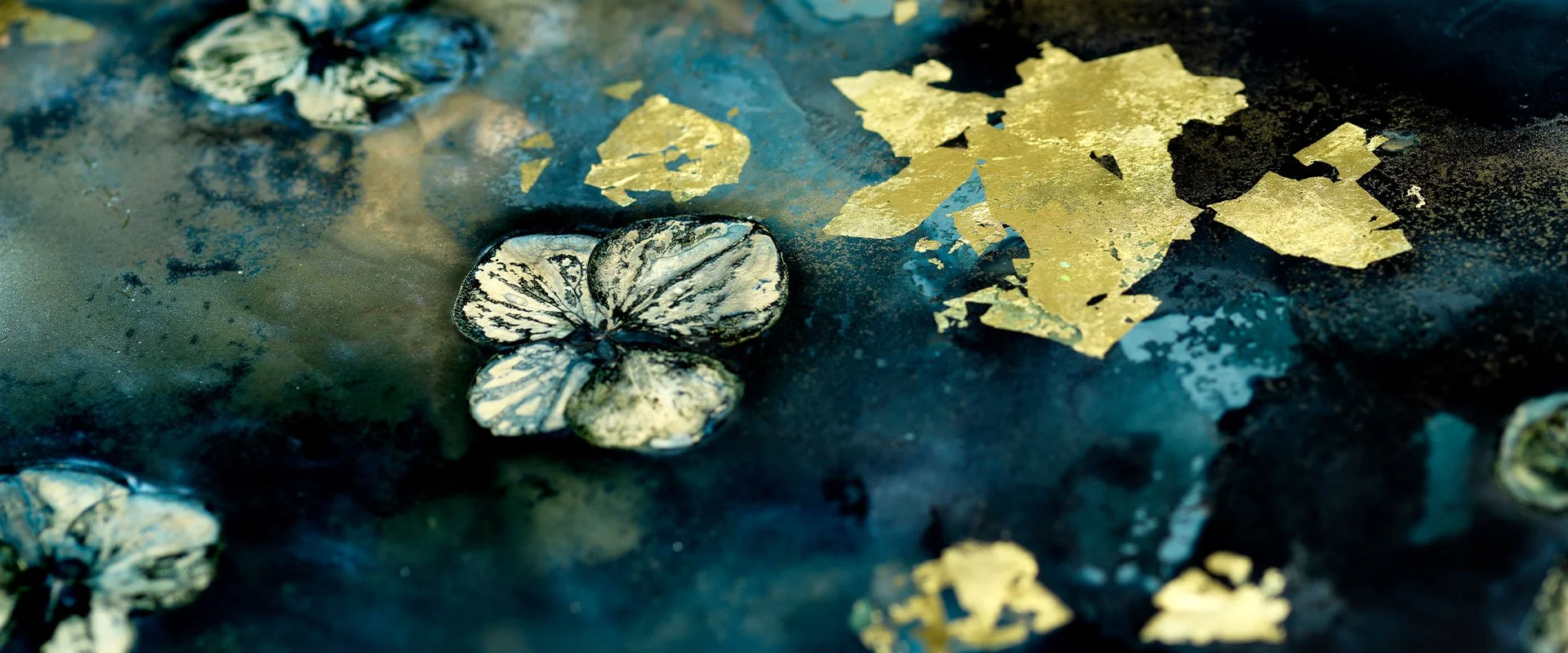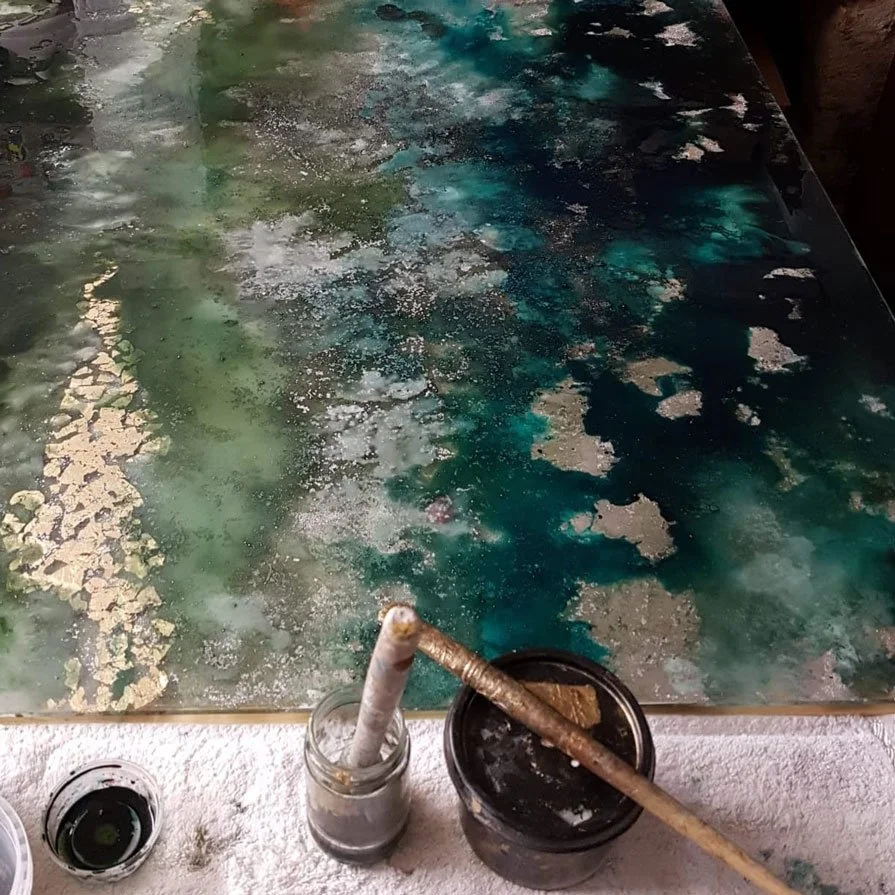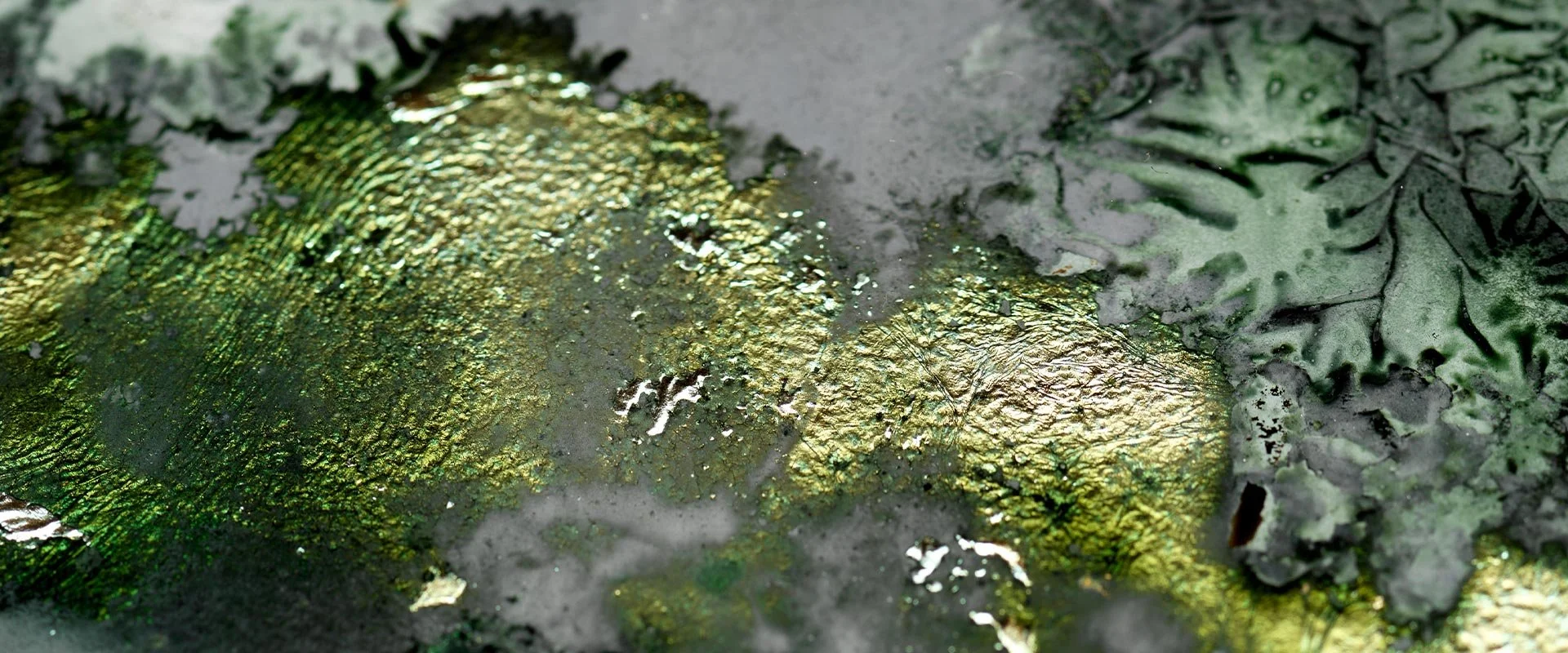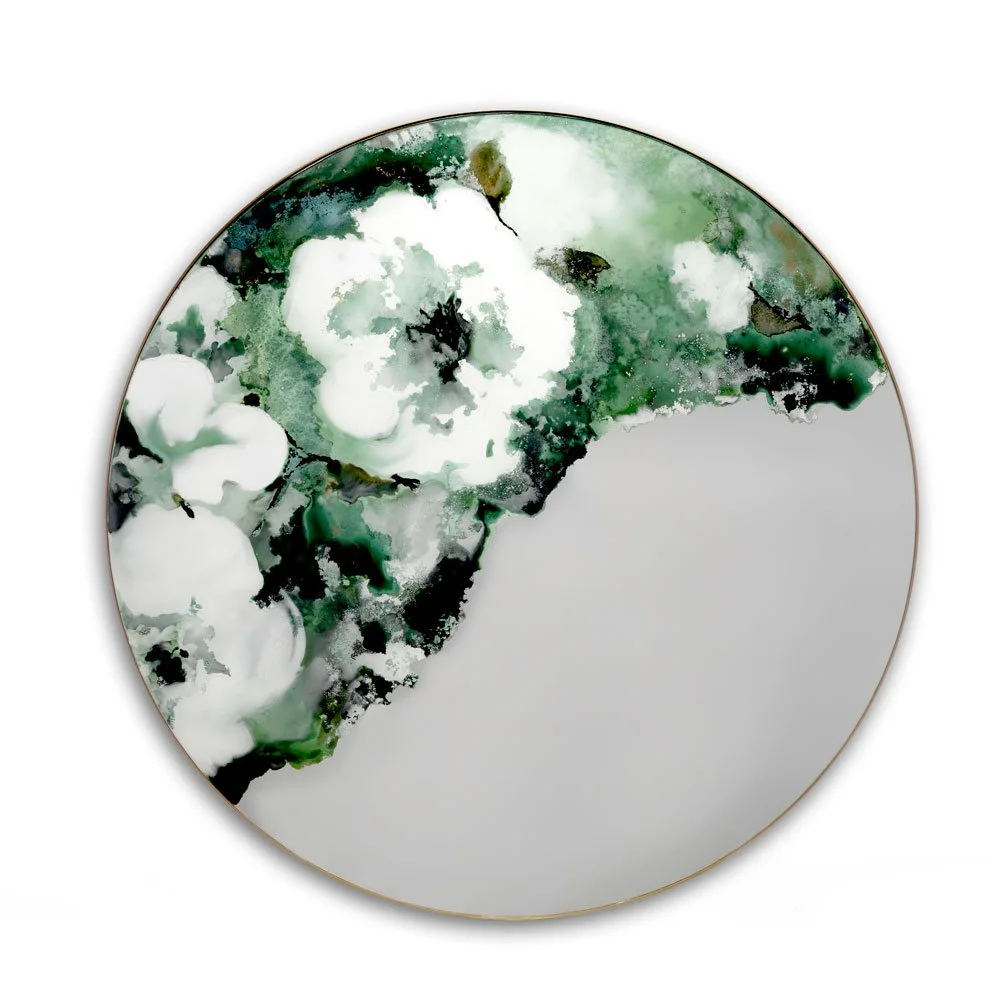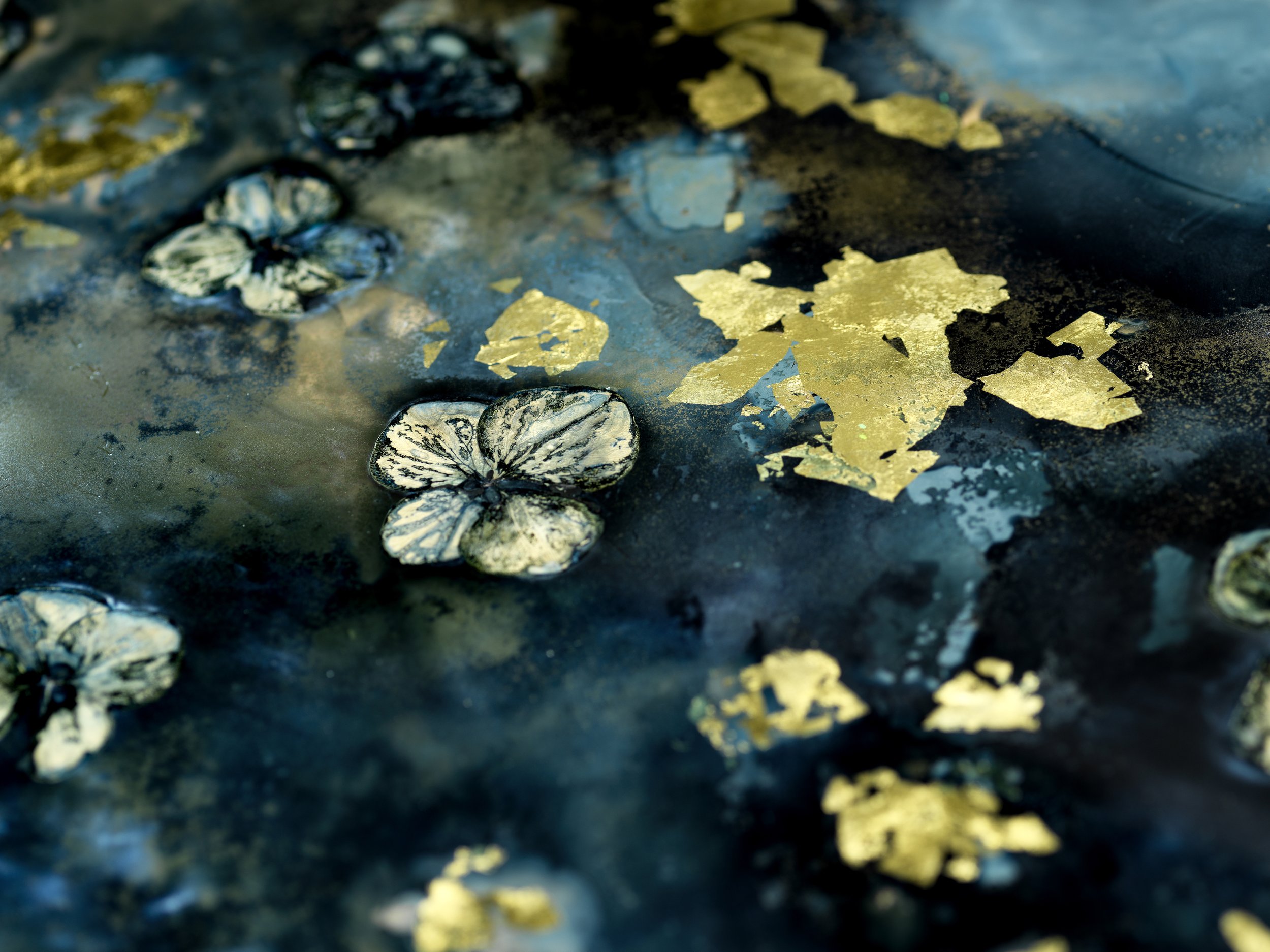
vErrE ÉGLoMISÉ
The ancient form of gilding glass
vErrE ÉGLoMISÉ AND GILDED GLASS
What is Verre Églomisé?
Verre Églomisé is an ancient form of gilding glass that pre-dates the Roman era, but its resurgence came about in the 18th century thanks to French decorator Jean-Baptiste Glomy (1711–1786). In 18th century France, Verre églomisé was a popular method used to make decorative pieces such as vases, mirrors, chandeliers, clocks, and other items. Verre Églomisé, is the French term for “gilded glass” and refers to the process of applying both a design and gilding onto the rear face of glass to produce a mirror finish. Églomisé is the term used to describe this decorative technique, and is usually executed on a panel of glass backed with gold or silver leaf. The technique involves engraving a design through the leaf and applying coloured pigment so that the coloured portions show through the engraved areas. This technique creates wonderful elegant mirrors and reflective surfaces for bespoke furniture pieces.
Verre Églomisé Processes
The leaf is applied to a glass panel with a thin layer of water-based size. The gold size is hand-mixed using a recipe of gelatine and water, and if the ratio is just right the gold leaf is sucked down onto the glass resulting in a mirror-like, reflective finish. The design is usually applied by reverse painting before the gilding process, and then by engraving the design into the gilded layer. Here the artist's natural methodology is reversed, with highlights applied first and the background applied last. Many techniques are used to achieve the desired effect to create works that are both functional and decorative.
The process takes place in three stages. First, our artists draw the desired pattern onto paper, tracing it directly onto the glass. Then the traced image is placed on the glass and a layer of transparent glue is applied. Finally, the paper backing is removed and leaves the design exposed to dry overnight. The decoration technique is labour intensive and requires great skill to produce beautiful decorative finishes and artwork for wall panelling, table surfaces and decorative mirrors. We start with painting a design on the reverse of clear glass. Once we have built up the design, we then apply gold, silver or metal leaf, resulting in a decorative reflective surface. It’s also possible to apply a leaf to clear glass which gives you stunning mirrors of the colour of leaf chosen.
Once left for a minute or two, any transfer tissue can be carefully lifted from the glass revealing the thin layer of gold beneath. The strength of gold size and drying time can create unique patterns between the gold leaf and tissue backing, meaning the remaining gold layer is seldom uniform in its appearance. The gilded glass panel must then be left to fully dry before it can be drawn onto using a fine needle or hard pencil.
Verre Églomisé Design
Commissioning a fully bespoke piece of work is an exciting and collaborative experience which begins with a consultation to understand your vision for the piece. Concepts, colour schemes and technical aspects for the final piece are outlined, taking your inspiration to form the basis on how the final piece will look. We'll develop a colour palette and sketch any artwork ideas to form the basis of the work required.
The commissions received from interior designers & architects are executed in a truly collaborative process with any drawings provided forming the parameters for the style and scope of work. Clients can provide specific designs they would like to see realised in églomisé, or they can utilise our excellent design skills to further the work. We then work to produce compositions, scaled sketches and verre églomisé samples for final approval, until the design process is complete, and all elements have been agreed. Our team then embarks on the production process.
Modern Materials
Today, there are many types of new materials that can be used to coat glass surfaces, and our artists are exploring how to use these to create decorative finishes for artworks, wall panelling, table surfaces and decorative mirrors. There are now many more types of leaf that can be used including silver, copper, aluminium, nickel, chrome, and bronze. And also with many more pigments available to use, our artists are always exploring new innovative ways to create exciting ornate designs.
Gilded Glass
For the gilding process, we apply high carat gold, silver or other metal leaf combined with polychromes to achieve the mirror-like reflective finish, which is applied to the glass using a delicate gelatine glue. We can work to any colourway and design artwork to compliment any interior scheme. Real gold, silver, platinum can be used for the gilded sections, or any precious metal leaf.
Water Gilding With Real Leaf
In general, leaf can fade if not sealed, and it may also fade when exposed to UV light. A good quality UV sealer can prolong the colour of the leaf, but we can also let the leaf fade naturally in sunlight to create muted tones. Genuine gold leaf is the most popular as this allows for more variety of textures and patterns. A high carat gold leaf won't tarnish so much, but leaf metals like copper and brass leaf can be used, but will oxidise and change over time, even when sealed. Silver leaf can also be used for some designs and can be allowed to live, or made stable with the suitable sealer.
Variegated Metal Leaf
We often use variegated metal leaf which are metal leaf flakes that have been mechanically shredded into a multitude of fine flakes, almost like confetti. They can be used in a number of ways, perhaps lightly sprinkled onto a tacky surface to add splashes of colour or used to create a cracked leaf finish by applying them to a sized surface before gently rubbing them flat to the surface. As flaked leaf is made from imitation gold leaf, imitation silver leaf and various variegated leaves it is prone to tarnishing and will need protecting with a clear lacquer or varnish to preserve it's finish.
Dutch Gold
A high carat real gold should remain true in colour and will not tarnish, but a 'Dutch gold' can also be applied to the glass. This imitation gold and will age and tarnish over time, adding interest and a deeper texture to the work. Layers of paints/pigments are then added and some final back-gilding, in semi-transparent sections, for luminous highlights. Gilded with Dutch gold fragments, hand painted with pigments, paints, powders. The semi transparent leaves are then back-gilded to add highlighted sections.
Reverse Painted Glass
Pigments and powders, and gold leaf applied to areas that are distressed once the original layer of silver has dried and adhered to the glass. The decorative glass surfaces are made from reverse painting glass. We work with many different colours and materials to make truly original designs. Painting on glass with coloured metallic-effect mica powder pigments that create eye-catching shimmering colour effects which move and react in the light. We generally use low iron glass at 4 to 12mm thick, depending on the usage and how it is to be installed and can add in edge details such as bevels, or cut outs, laminating and shaping of the glass. Almost all glass that we work with is toughened which cannot be altered once it has been processed.
Antiqued Mirror
The use of gilding glass produces a reflective surface, producing a mirror like finish on the surface that resembles antique mirror. These mirrored surfaces use different leaf types and coloured pigments for this gilded glass technique, and gives rise to a wide range of antique mirror surfaces which can be used in a variety of luxury furniture applications.
A distressed hand gilded mirror is another term for a type of mirror that has been chemically treated to give it a distressed appearance, like foxing. This treatment creates a natural patina that gives the piece a vintage feel. Please see the link to our antique mirror materials page for more examples:
Modern Techniques
Today, special paints in strong, lightfast colours have been developed for the signwriting trade which allow us to produce colour charts by mixing these pigments to create a palette of suitable colours for the bespoke surface. We use a number of techniques to create our contemporary verre églomisé, which include etching designs into the glass and leaf. We also use a decoupage technique to break up the leaf into fragments to form abstract patterns. Whilst a floral design remains popular, with etched flower motifs on much of our work, we are also able to produce more modern abstract designs for a more contemporary look.
Applications
There are a wide range of applications for these bespoke decorative mirror-like surfaces. We co-ordinate with our our artists and furniture makers to make the process straightforward so that the end result surpasses all expectations.
Luxury Bespoke Furniture Design
For designing luxury bespoke furniture, a verre églomisé surface could be used for a table top, such as a side table or console, or even as a dining table surface. We can also make eglomise panels for doors of sideboards, credenzas, and cupboards or bar cabinets.
Eglomisé Feature Mirrors
A decorative mirror is a common use for verre églomisé, which acts as a stand-alone piece of artwork. We have produced a number of round wall mounted mirrors with a circular metal frames. It's also possible to make an entire feature wall using decorative panels of mirrors using the same technique but on a much larger scale.
If you would like to understand more about this finish or discuss a project, please do get in touch:
